The Culture of the Aztec Civilization
An Introduction to the Aztec World
The Aztec civilization was a powerful and complex society in central Mexico. It existed from about 1300 to 1521. Their culture was a mix of strong military power, smart farming, and deep religious beliefs.
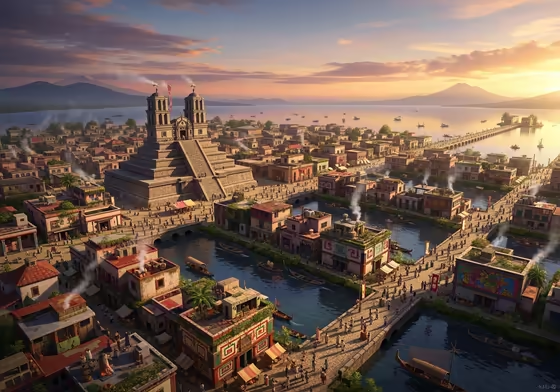
To understand the Aztecs, we have to see how their religion was tied to everything they did. The stars and planets guided their daily lives. They started as a wandering tribe and grew to rule a huge empire.
Their legacy includes giant buildings, a complex social system, and religious practices that still fascinate us today. The Aztecs believed they needed both farming and warfare to keep their empire, and the universe itself, in balance.
Defining the Aztecs: From Mexica to Empire
The name "Aztec" is actually a modern term. Researchers in the 19th century started using it to describe the different groups of people in central Mexico who spoke the Nahuatl language. The name comes from Aztlán, their mythical homeland.
The people at the heart of the empire called themselves the Mexica (pronounced Meh-SHEE-kah). The country of Mexico is named after them. While "Aztec" can refer just to the Mexica, it is often used to describe the entire empire they controlled.
The Aztec Empire was not controlled by a single ruler in the way European kingdoms were. It started as the Triple Alliance in 1427 between three city-states: Tenochtitlan, Texcoco, and Tlacopan. This alliance worked together to become the main power in the area.
Over time, Tenochtitlan became the most powerful city in the alliance. This made the Mexica the leaders of the new empire.
The Mythic Origins and the Founding of Tenochtitlan
The Mexica were newcomers to the Valley of Mexico, arriving from the north around the 12th or 13th century. Their stories tell of a long journey from their original home, Aztlán. This journey was ordered by their main god, Huitzilopochtli, who was the god of the sun and war.
According to legend, Huitzilopochtli told them to build their city where they saw a special sign. This sign was an eagle sitting on a cactus, eating a snake. After years of wandering, the Mexica saw this sign in 1325 on a swampy island in Lake Texcoco.
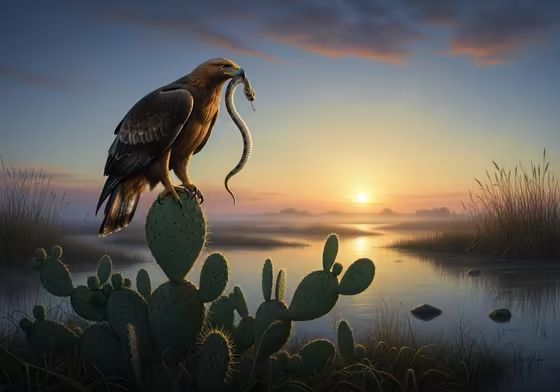
They obeyed their god and founded their capital, Tenochtitlan, on that spot. This powerful story became a key part of their identity. Today, this image of the eagle is the center of the modern flag of Mexico.
Pillars of Aztec Culture: War, Agriculture, and Faith
The Aztec way of life was built on three main ideas: war, farming, and religion. This is best seen in their main temple in Tenochtitlan, the Templo Mayor. It had two pyramids side by side.
One pyramid was for Huitzilopochtli, the god of war. The other was for Tlaloc, the god of rain and farming. This showed the empire’s core belief that war provided tribute and sacrifices for the gods, while farming provided food for the people.
War was a constant part of life and the main way the empire grew. It allowed the Aztecs to conquer other cities and demand tribute, which was a type of tax paid in goods, labor, or people. War was also a sacred duty, as captured warriors were needed for human sacrifices to keep the gods happy.
At the same time, farming was the base of their economy. On their island city, they created amazing floating gardens called chinampas. These gardens turned the swampy lake into a rich food source that could feed the city's huge population.
The Mexica rose to power by creating a strong identity for their empire. They adopted the gods and art styles of older cultures they respected, like the Toltecs. Their legend of the eagle on the cactus gave them a divine right to rule.
The "Aztec culture" we know is mostly the culture of the Mexica, which was designed to unite their diverse empire. However, many conquered people were unhappy. This unhappiness was a key weakness that Spanish invaders later used to their advantage.
Key Cultural Highlights and Misconceptions
To understand Aztec culture, it helps to know some key facts and common misunderstandings.
Five Facts About the Aztecs:
- They Called Themselves the Mexica: The people at the center of the empire were the Mexica. Their name is the origin of the modern name of Mexico. "Aztec" was a name created later to describe the larger group of people from the mythical land of Aztlán.
- They Valued Chocolate as Currency: Aztecs grew cacao beans, which were so valuable they were used as money in their markets. They drank chocolate as a bitter, foamy drink called xocolatl, often spiced with chili peppers.
- They Mandated Universal Education: The Aztec government required all children, including boys, girls, nobles, and commoners, to go to school. This was very advanced for its time. This system helped pass down their culture, history, and religious beliefs.
- They Built a Metropolis on a Lake: Tenochtitlan was a marvel of engineering. It was home to about 200,000 people, making it one of the largest cities in the world at the time. It was built on man-made islands and connected to the mainland by large bridges.
- Human Sacrifice Was a Core Religious Practice: Though often exaggerated in Spanish stories, human sacrifice was a serious and central part of Aztec religion. They believed it was necessary to repay the gods who had sacrificed themselves to create the universe.
Three Cultural Facts About the Aztecs:
- A Complex Calendrical System: The Aztecs used two calendars to organize their lives. The xiuhpohualli was a 365-day calendar for farming, while the tonalpohualli was a 260-day sacred calendar for religious rituals and predictions.
- A Highly Stratified Society: Aztec society was strictly divided into social classes, mainly the nobles (pipiltin) and the commoners (macehualtin). Each class had different laws, rights, and clothing that defined their place in the world.
- A Syncretic and Expansive Religion: The Aztec religion had over 200 gods. They often adopted gods from the cultures they conquered, like the Toltecs. This created a rich and complex religion that reflected their powerful empire.
The Fabric of Daily Life in Aztec Society
Daily life in the Aztec Empire was very organized. It was shaped by a person's social class, farming needs, and a belief that every activity had a divine purpose. Life followed the rhythm of the sun, the seasons, and the sacred calendars.
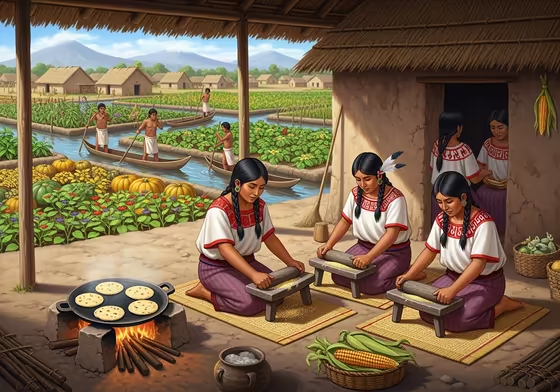
A Day in the Life: Commoners, Nobles, and the Rhythm of the Cosmos
For most people, who were commoners or macehualtin, life began at sunrise. Men went to work in the fields or on public projects like building temples. Women would spend hours grinding corn to make tortillas for the day.
The day was marked by sounds from the temples, where priests would blow conch-shell trumpets to mark the time. Commoners lived in simple one-room homes made of adobe bricks. In contrast, nobles, or pipiltin, lived in large stone palaces with many rooms and courtyards.
The Aztecs also had fun. They played a popular board game called patolli. They also watched a ceremonial ball game called ōllamalitzli, though it was usually played by nobles.
One of the most surprising things about Aztec cities was how clean they were. The streets of Tenochtitlan were swept and washed daily. Most Aztecs bathed at least once a day, which was very different from cities in Europe at the time.
The Aztec Diet: Sustenance from Chinampas and Tribute
The Aztec diet was healthy and diverse. The main foods were the "Three Sisters": corn (maize), beans, and squash. These crops were often grown together in a system that kept the soil rich.

Corn was more than just food; it was considered sacred. Aztecs developed a special process to soak and cook the corn, which made it more nutritious. The resulting dough was used to make tortillas, the daily bread of the Aztec world.
The diet was mostly vegetarian, but they also ate other things. They raised turkeys and a type of hairless dog for meat. They also ate fish, frogs, insects, and algae from the lake.
Nobles ate luxury foods that came from tribute payments. This included cacao for their chocolate drinks and fresh fish brought from the coast by fast runners.
Adornment and Status: The Significance of Aztec Clothing
In Aztec society, clothing showed a person's social status, rank, and achievements. The empire had strict laws about who could wear certain materials and colors. Breaking these laws could lead to harsh punishments, including death.
The basic clothing for men was a loincloth and a cloak called a tilma. A commoner's tilma was made of rough plant fiber, while a nobleman wore one made of soft, colorful cotton.
Women wore a long skirt and a sleeveless blouse. Like with men's clothing, the quality of the fabric and embroidery showed a woman's wealth and status.
Accessories were also important symbols of status. Only nobles could wear sandals in Tenochtitlan. The most valuable material was the bright green feathers of the Quetzal bird, which were reserved for the emperor and high-ranking nobles.
For warriors, clothing showed their success in battle. The most elite warriors belonged to the Jaguar and Eagle orders. They wore amazing costumes made from jaguar skins or eagle feathers, with helmets shaped like the animal's open mouth.
The strict rules for daily life reflected the Aztec belief in a balanced universe. They thought that a strict social order on Earth helped maintain cosmic stability. By following the rules, every person helped keep the world running properly.
The Cosmos, The Gods, and The Afterlife: Aztec Religion
Religion was the most important force in Aztec culture, touching every part of life. Their complex belief system tried to explain the universe and the delicate balance needed to keep it from being destroyed. They believed the gods needed constant praise and sacrifice to prevent disaster.
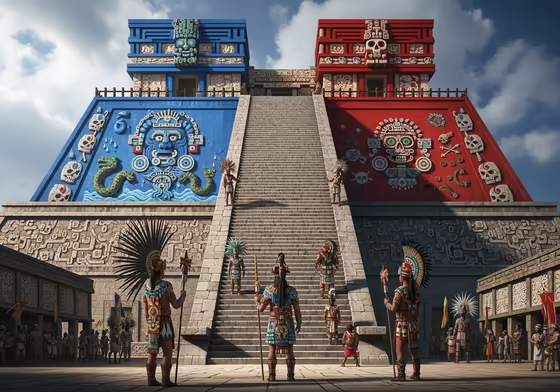
A Pantheon of Deities: The Nature of Aztec Gods
The Aztecs had over 200 gods, partly because they adopted gods from the people they conquered. They believed the world had been created and destroyed four times before, and they were living in the fifth "Sun." Their universe had 13 heavens above the Earth and 9 underworlds below.
While there were many gods, a few were most important:
- Huitzilopochtli: He was the main god of the Mexica, the god of the sun and war. They believed they had to feed him with sacrificial blood to keep him strong.
- Tlaloc: An ancient god of rain and farming. He was essential for growing corn, but his anger could cause droughts or floods.
- Quetzalcoatl: The "Feathered Serpent" was a god of wind, creation, and knowledge. He was seen as a hero who brought civilization to humans.
- Tezcatlipoca: The "Smoking Mirror" was a powerful god of the night sky, fate, and magic. He was a trickster god who could bring good or bad fortune.
A key idea in Aztec religion was duality, or the balance of opposite forces. Many gods represented both creation and destruction. The world was seen as a constant struggle between these divine forces that kept the universe in balance.
Ritual, Ceremony, and the Practice of Human Sacrifice
The Aztec year was filled with festivals and ceremonies. Each of the 18 months in their solar calendar was dedicated to specific gods. These public events included feasting, dancing, music, and flowers to honor the gods and ensure good harvests.
The most well-known part of Aztec religion was human sacrifice. They believed this was necessary for the survival of the universe. According to their myths, the gods had sacrificed themselves to create the world, and humans had to repay this debt with their own lives.
The sun god, Huitzilopochtli, needed a daily offering of human blood to have the strength to rise each morning. Most victims were prisoners of war. While Spanish stories may have exaggerated the number of sacrifices, archaeological evidence confirms it was a widespread practice.
The Aztec Conception of Death and the Soul's Journey
In the Aztec view, death was not an end but a journey to another stage of existence. A person's destination in the afterlife was decided not by how they lived, but by how they died.
The Aztecs believed people had different souls that went to different places after death. There were three main destinations:
- Ōmeyōcān (The House of the Sun): This was the best afterlife, reserved for those who died in noble ways. Warriors who died in battle and people who were sacrificed went here. Women who died in childbirth were also honored this way. After four years, their souls could return to Earth as hummingbirds or butterflies.
- Tlālōcān (The Paradise of Tlaloc): This was a joyful paradise with endless spring. It was the destination for people whose deaths were related to water, like drowning or being struck by lightning.
- Mictlān (The Underworld): Most people who died of old age or sickness went to this dark underworld. Their souls had to pass through nine difficult levels over four years. At the end of the journey, the soul would finally find rest.
Funerals were important rituals to help the soul on its journey. For four years after a death, the family would make offerings and perform ceremonies to support the soul as it traveled through the underworld.
The Sacred Numbers: Cosmology and the Meaning of 13
Numbers had deep meaning for the Aztecs, and the number 13 was especially important. They believed the universe had 13 heavens, or levels, above the Earth. The highest heaven was the home of the creator god.
This structure was also reflected in their sacred 260-day calendar. This calendar was based on a cycle of 20 day signs combined with numbers from 1 to 13. The number 13 represented a complete cycle of sacred time, used for predicting the future and planning rituals.
The Aztec idea of the afterlife shows what their society valued most. The best afterlife was not for people who were good, but for those whose deaths served the empire. Warriors and women who died in childbirth were essential to the empire's survival, so their deaths were given the highest honor.
The Voice of the Empire: Language and Writing
Communication was key to running the large Aztec Empire. They used a popular spoken language, Nahuatl, and a unique writing system to record important information like taxes and history.
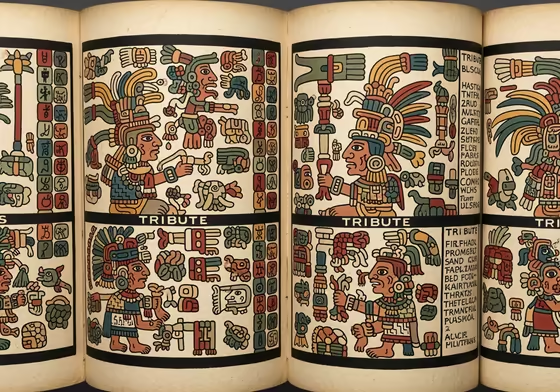
Nahuatl: The Lingua Franca of Mesoamerica
The language of the Aztecs was Nahuatl. As the Aztec Empire grew, their version of Nahuatl became the main language for government and trade across the region. It was spoken from northern Mexico down to parts of Central America.
Nahuatl is known for its ability to form long, complex words by joining smaller parts together. The name "Nahuatl" is thought to mean "clear speech" or "good sounds."
Nahuatl is still spoken today by about 1.7 million people in Mexico. Many Nahuatl words have also made their way into Spanish and English. Words like chocolate, tomato, avocado, chili, and coyote all come from Nahuatl.
The Aztec Script: A System of Glyphs and Pictographs
The Aztecs did not have an alphabet. Instead, they used a writing system with pictures and symbols, called glyphs, to represent objects, ideas, and sounds. This system was used by trained scribes to record information in beautiful folding books called codices.
The writing system worked in a few ways:
- Pictograms: A direct picture of an object. For example, a drawing of a shield could represent war.
- Ideograms: A symbol for an idea. A scroll coming from a person's mouth meant speech, while a burning temple meant conquest.
- Phonetic Rebuses: Glyphs could also be used for their sound value to spell out names and places.
Sadly, most of these amazing books were destroyed by Spanish missionaries who thought they were evil. Only a few have survived. These documents are now our best source of information about Aztec history, religion, and daily life.
The Engine of an Empire: Economy, Tribute, and Trade
The Aztec Empire was an economic powerhouse. Its economy supported a huge population, paid for constant wars, and created amazing art and architecture. Its strength came from smart farming, a vast tribute system, and busy trade networks.
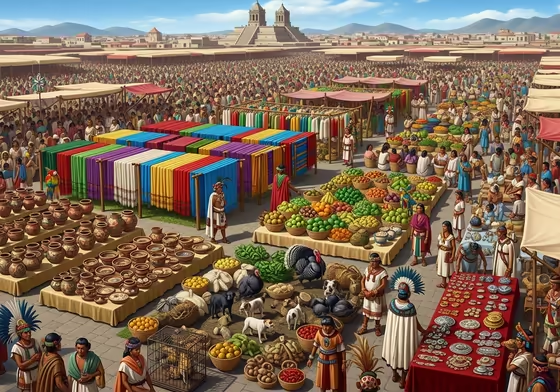
The Three Pillars: Agriculture, Tribute, and Commerce
Farming was the foundation of the Aztec economy. Their most amazing achievement was the chinampa, or "floating garden." These were man-made islands in the shallow lakebed that were incredibly fertile, allowing for multiple harvests a year.
The second pillar was the tribute system. Conquered cities were forced to pay regular tribute to Tenochtitlan. This tribute included food, raw materials, warrior costumes, and luxury goods like jade, gold, and feathers.
The third pillar was trade. Local markets were used for everyday goods, while professional merchants traveled long distances to trade for luxury items. This was vital because many important goods, like cotton and cacao, could not be grown in the high Valley of Mexico.
The Marketplace: A Center of Economic and Social Life
The marketplace, or tianquiztli, was the heart of Aztec commerce. The biggest market was in Tlatelolco, where over 60,000 people gathered daily to buy and sell goods. These markets were also important social centers where people could meet and share news.
You could find almost anything at the market, from food and tools to medicine and luxury goods. Government officials watched over the market to make sure prices were fair and goods were high quality.
Long-distance trade was handled by a special class of merchants called the pochteca. They traveled to faraway lands to get rare goods for the nobility. Because they knew so much about other regions, they also served as spies for the emperor.
Currency and Exchange: From Cacao Beans to Cotton Cloth
The Aztec economy did not use coins. Most trade was done through barter, which is trading one good for another. However, they did use certain items as a form of money.
For small purchases, cacao beans were the most common currency. They were valuable, easy to carry, and easy to count.
For larger purchases, they used standardized lengths of cotton cloth called quachtli. These cloths represented a certain amount of labor and were a recognized unit of value.
The tribute system that made the empire rich was also its greatest weakness. The conquered people were resentful of the Aztecs. When the Spanish arrived in 1519, they were able to make alliances with these unhappy groups, which was key to their conquest of the empire.
The Aztec Empire: Governance and Social Structure
The Aztec Empire had a unique system of government and a strict social structure. At its peak, the empire ruled millions of people from its capital city of Tenochtitlan.
The Triple Alliance and the Mechanics of Imperial Rule
The empire was founded on the Triple Alliance between the city-states of Tenochtitlan, Texcoco, and Tlacopan. Over time, the Mexica of Tenochtitlan became the clear leaders of this alliance.
The top ruler was the emperor of Tenochtitlan, the Huey Tlatoani or "Great Speaker." He was chosen from the royal family and was seen as a semi-divine figure. He was the head of the military, the main priest, and the final judge.
The Aztecs usually ruled conquered cities indirectly. They let local leaders stay in power as long as they paid regular tribute and provided soldiers for Aztec wars. This system was efficient but created a lot of resentment.
The Social Strata: From Pipiltin to Macehualtin
Aztec society was deeply divided between nobles and commoners. A person's place in society was usually determined by birth, but it was possible for some people to move up.
| Class (Nahuatl Term) | Role in Society | Rights and Privileges | Obligations |
|---|---|---|---|
| Huey Tlatoani | Supreme ruler, emperor | Total political, military, and religious power; seen as part god | To lead the empire in war and religion |
| Pipiltin (Nobility) | Government officials, priests, military commanders | Owned land, received tribute, wore luxury clothes, attended elite schools | To govern the empire, lead armies, and perform priestly duties |
| Pochteca (Merchants) | Long-distance traders, sometimes spies | Had their own guilds and laws, could become very wealthy | To bring rare luxury goods to the capital for the nobility |
| Macehualtin (Commoners) | Farmers, artisans, soldiers | Could use community land for farming, attended public schools | To farm, serve in the military, and pay tribute in goods and labor |
| Tlacotin (Slaves) | Laborers, debtors | Could marry, have free children, own property, and buy their freedom | To serve their owner until their debt was paid |
The Pipiltin, or nobility, were the ruling class. They held the top jobs in government, the priesthood, and the military. They were easily identified by their fine cotton clothes and jewelry.
The Macehualtin, or commoners, were the largest part of the population. They were mostly farmers and soldiers. They had to pay tribute to the nobles and the state with their crops and labor.
At the bottom of society were the Tlacotin. Aztec slavery was very different from slavery in other parts of the world. It was not based on race, and it was not for life. Slaves had legal rights and could buy their own freedom.
The Role of the Calpulli in Community Organization
The basic unit of society for commoners was the calpulli, which means "big house." It was like a neighborhood or clan based on family ties. Each calpulli had its own leader, temple, and school.
The calpulli was in charge of the well-being of its members. It managed community land, assigning plots to families to farm. This system helped the state organize its population, collect tribute, and gather labor for big projects.
Enduring Innovations: Aztec Achievements and Contributions
The Aztec civilization was known for more than just its military. They made incredible achievements in engineering, city planning, astronomy, and medicine that were among the most advanced in the world at the time.
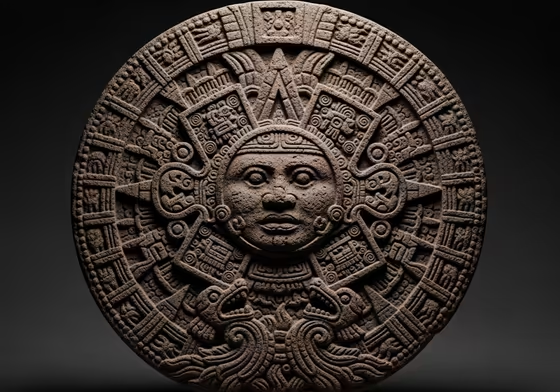
Five Major Aztec Achievements:
- Advanced Agriculture (Chinampas): The Aztecs perfected the chinampa, or "floating garden." These were man-made islands built in the lake that were extremely fertile. This brilliant system allowed them to feed their huge city population and is still used today.
- Monumental Architecture and Urban Planning: The Aztecs were master builders. Their capital, Tenochtitlan, was an amazing city built on an island. It had massive stone bridges, canals for streets, and aqueducts that brought fresh water to the city.
- A Sophisticated Calendrical System: The Aztecs used two very accurate calendars at the same time. One was a 365-day calendar for farming, and the other was a 260-day sacred calendar for religious rituals. This shows their advanced understanding of math and astronomy.
- Universal Compulsory Education: The Aztecs were one of the first societies to require education for all children. Noble children went to one type of school to learn to be leaders, while commoner children went to another to get military training and learn a trade.
- Herbal Medicine and Pharmacology: The Aztecs had a deep knowledge of medicinal plants. They used hundreds of plants to treat illnesses and injuries. Their medical practices also included setting broken bones and using steam baths for healing.
Artistic Expression: Sculpture, Featherwork, and Codices
Aztec art was closely tied to their religion and government. It was meant to honor the gods and show the power of the empire. Their art is known for being powerful, symbolic, and dramatic.
Aztec stone sculpture is one of the most powerful art forms from the ancient world. They created amazing and sometimes scary statues of their gods.
- The Aztec Sun Stone: This huge stone disk is not a calendar, but a map of the Aztec cosmos. It shows the five creations of the world and their calendar symbols.
- The Statue of Coatlicue: A terrifying statue of the earth goddess, who is shown with a skirt of snakes and a necklace of human hearts.
- The Coyolxauhqui Stone: A large, round stone showing the dismembered body of the moon goddess.
The Aztecs considered featherwork to be more valuable than gold. Artists created stunning mosaics from the tiny, colorful feathers of birds like hummingbirds and the sacred quetzal. They also made beautiful mosaics with turquoise and jade.
A Tapestry of Tradition: Aztec Cultural Practices
The Aztec world was held together by rich cultural traditions. These practices gave meaning to life and reinforced the values of their society, such as devotion to the gods and respect for social order.
The Ceremonial Year: A Cycle of Festivals and Rituals
Aztec life followed the rhythm of their sacred calendars. The year was filled with religious festivals, with each month dedicated to a different god. These festivals were tied to the farming seasons, celebrating planting and harvesting.
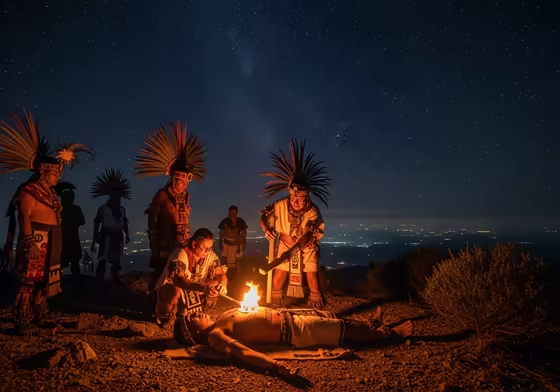
These ceremonies were huge public events involving the whole community. A dramatic part of many festivals was choosing a person to act as a god impersonator. This person was treated like a god until the climax of the ceremony, when they were sacrificed.
The most important ritual was the New Fire Ceremony, held only once every 52 years. The Aztecs believed the universe could end at the conclusion of this cycle. All fires in the empire were put out, and priests would try to start a new fire to signal that the world would continue.
Social Etiquette and the Law
Aztec society valued proper behavior, dignity, and self-control. Children were taught from a young age how to speak, walk, and eat politely. Some of their rules for good manners included:
- Not making fun of the elderly or sick.
- Speaking calmly and not interrupting others.
- Showing respect with formal greetings.
- Avoiding direct physical contact with superiors.
These social rules were supported by a strict legal system. Courts with experienced judges heard cases on everything from theft to divorce. Punishments were harsh and quick to maintain the order that society depended on.
Mesoamerican Context: What cultures were like the Aztecs?
The Aztec civilization was the last in a long line of great cultures in Mesoamerica. They inherited traditions from earlier civilizations and shared many cultural traits with them. These shared traits included:
- Farming based on corn, beans, and squash.
- Building giant pyramid-temples.
- A complex religion with many gods.
- Using a 260-day sacred calendar.
- Playing a ritual ball game.
- A system of writing using pictures.
The Aztecs greatly admired the Toltecs and the ancient civilization of Teotihuacan. They claimed to be descended from Toltec kings to justify their own rule. They were so impressed by the ruins of Teotihuacan that they believed it was a city built by giants.
It is helpful to compare the Aztecs with the other two great American civilizations at the time: the Maya and the Inca.
| Trait | Aztec | Maya | Inca |
|---|---|---|---|
| Time Period | c. 1300–1521 | c. 2000 BCE–1500s | c. 1438–1533 |
| Geography | Central Mexico (highlands) | S. Mexico & Central America (jungle) | South America (Andes Mountains) |
| Political Structure | Tribute Empire (Triple Alliance) | Independent city-states | Centralized empire with direct rule |
| Writing System | Pictures and symbols | Fully developed hieroglyphs | None (used knotted strings called quipu) |
| Key Innovation | Chinampa farming | Advanced math (concept of zero) | Huge road network, masterful stonework |
| Capital City | Tenochtitlan | Many major cities (e.g., Tikal) | Cusco |
This comparison shows that while these civilizations had some things in common, they were also very different. The Aztecs were great engineers and administrators. The Maya were brilliant astronomers and writers, and the Inca were master builders on a massive scale.
The Living Legacy: Modern Influence and Descendants
The fall of Tenochtitlan in 1521 was the end of the Aztec Empire, but not the end of Aztec culture. The influence of this powerful civilization can still be seen in modern Mexico. The descendants of the Aztecs continue to live in Mexico today, carrying on their cultural heritage.

How is Aztec culture seen today?
The legacy of Aztec culture is everywhere in Mexico. The country's national symbol, the eagle on a cactus eating a snake, comes directly from the Aztec story of how they founded Tenochtitlan. It is the centerpiece of the Mexican flag.
The powerful designs and vibrant colors of Aztec art inspire modern fashion, art, and interior design. You can see these patterns on everything from wall murals to clothing.
The world-famous Day of the Dead (Día de los Muertos) has roots in Aztec beliefs. It combines ancient ideas about honoring ancestors with Catholic traditions.
The most widespread Aztec legacy is in food. Many of the world's favorite foods, like corn, beans, tomatoes, avocados, and chocolate, were first grown by the Aztecs. Modern Mexican food is a delicious blend of these native ingredients and Spanish cooking.
Is Aztec culture still alive?
Yes, Aztec culture is definitely still alive, though it has changed over the centuries. The empire is gone, but the people and their traditions continue. The direct descendants of the Aztecs are known today as the Nahua people.
Today, more than 1.5 million people in Mexico still speak the Nahuatl language. The Nahua live in communities across central Mexico. Many of them still practice farming techniques and hold festivals that blend ancient traditions with modern influences.
Are Mexicans originally Aztecs? Are there any 100% Aztecs left?
This is a complex question. Most people in Mexico today identify as Mestizo, which means they have a mixed heritage of indigenous and European ancestors. While many Mexicans have indigenous roots, it's not just from the Aztecs.
Before the Spanish arrived, Mexico was home to many diverse cultures, like the Maya and Zapotec. To say all Mexicans are Aztecs would ignore this rich diversity.
The idea of a "100% Aztec" is also misleading. The Mexica themselves mixed with other groups, and 500 years of history has led to even more mixing. The direct descendants of the Aztecs are the modern Nahua people, whose culture has evolved over time.
The Aztec legacy is both a living culture, carried on by the Nahua people, and a powerful national symbol for Mexico. Understanding this legacy means recognizing both the living traditions of its descendants and the symbolic use of its past to build a modern nation.